.125 as a Fraction: Understanding Decimal to Fraction Conversion
In the world of mathematics, numbers can be represented in various forms, and one common way is through decimals. Decimals provide a convenient way to express numbers that fall between two whole numbers. However, there are instances where it's more practical or intuitive to represent decimals as fractions. In this article, we will delve into the concept of converting the decimal number .125 into a fraction. We will explore the step-by-step process, why it's essential, and how it can be useful in real-life scenarios.
Fractions with pictures dinosaur game online.
Beat the dinosaurs and arrive home
Online game on fractions shown on pictures.
Addition of fractions crocodile game online
Online board game on adding fractions
Add two fractions while playing with zombies
Zombie game on addition of mixed fractions
Zombie game on fractions with squares
Find the fraction values of numbers
Find the percentage of numbers game
War game online on fractions to decimals.
Online board game on comparison of fractions.
War board game on fractions for kids.
Fraction of a number game online
Wheel of fortune fractions game
Multiplication of two fractions spin the wheel.
Spin the wheel game on fractions of numbers.
Wheel spin convert fractions to decimals.
Fractions shown with pictures backball game
More games: Compare fractions basketball game | Addition of fractions basketball game online | Addition of mixed fractions |

The Basics of Decimal Numbers
Before we dive into converting .125 into a fraction, let's review the basics of decimal numbers. Decimals are a numeric system that represents parts of a whole. The term "decimal" itself comes from the Latin word "decimus," which means "tenth." In the decimal system, numbers are divided into units, tenths, hundredths, thousandths, and so on, with each position representing a power of 10.
Understanding .125
Decimal numbers are typically expressed with a point, such as 0.125. In this case, "0" represents whole numbers, "1" represents tenths, "2" represents hundredths, and "5" represents thousandths. So, the number .125 signifies one-tenth plus two-hundredths plus five-thousandths.
Why Convert Decimals to Fractions?
Now, you might be wondering, why bother converting decimals like .125 into fractions? Well, there are several reasons why this conversion can be valuable:
1. Enhanced Understanding
Converting decimals into fractions can make numbers more relatable and easier to understand. Fractions often represent portions of a whole, which can be more intuitive in various contexts.
2. Comparison and Equivalence
Fractions allow for easier comparison between numbers and finding equivalent values. It's often simpler to compare two fractions than two decimals.
3. Real-Life Applications
In many real-life situations, you'll encounter fractions rather than decimals. Understanding how to convert between the two forms can be incredibly useful in fields like cooking, construction, and finance.
Converting .125 to a Fraction
Now, let's get into the practical part of converting .125 into a fraction. The process is straightforward and involves the following steps:
Step 1: Identify the Decimal
In our case, the decimal is .125.
Step 2: Count the Decimal Places
Count how many decimal places are there in the number. In this case, there are three decimal places (tenths, hundredths, and thousandths).
Step 3: Create the Fraction
To convert the decimal .125 into a fraction, place the number over a power of 10 that corresponds to the number of decimal places. In this case, it will be 125/1000.
Step 4: Simplify the Fraction
Simplify the fraction by dividing both the numerator and denominator by their greatest common divisor. In this case, 125 and 1000 share a common divisor of 125. So, we simplify it to 1/8.
So, .125 as a fraction is equal to 1/8.
Practical Applications
Understanding the conversion of .125 into 1/8 can be valuable in various real-life situations. For instance:
- In cooking recipes, where you need to adjust ingredient proportions.
- In woodworking or construction, when measuring and cutting materials.
- In financial calculations, such as interest rates or profit margins.
Conclusion
In conclusion, converting decimals like .125 into fractions is a valuable skill that can enhance your mathematical understanding and practical problem-solving abilities. By following the simple steps outlined in this article, you can easily convert .125 into the fraction 1/8. This skill is not only useful in academic settings but also in everyday scenarios where fractions play a vital role.
Frequently Asked Questions (FAQs)
1. Can I convert any decimal into a fraction using this method? Yes, you can use this method to convert any decimal into a fraction.
2. Why is it important to convert decimals to fractions in real life? Converting decimals to fractions can make mathematical concepts more practical and applicable in various real-life situations.
3. Are there any online tools available for decimal to fraction conversion? Yes, there are many online calculators and tools that can perform this conversion automatically.
4. Can fractions be converted into decimals as well? Yes, fractions can be converted into decimals using division. The reverse process is also possible, as demonstrated in this article.
5. How can I practice and improve my decimal to fraction conversion skills? You can practice by taking decimal numbers and converting them into fractions manually. There are also educational resources and exercises available online to help you improve this skill.
